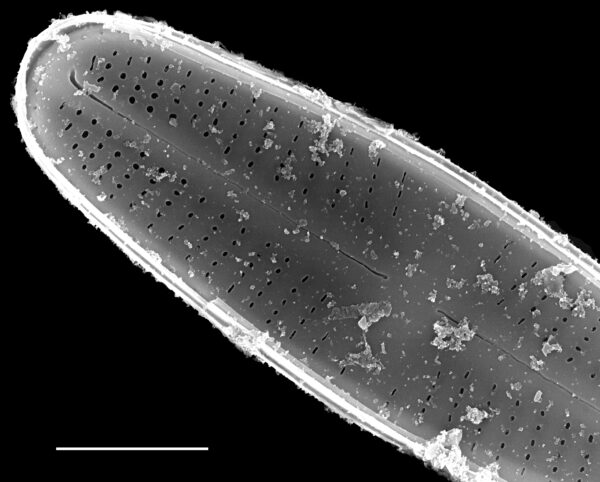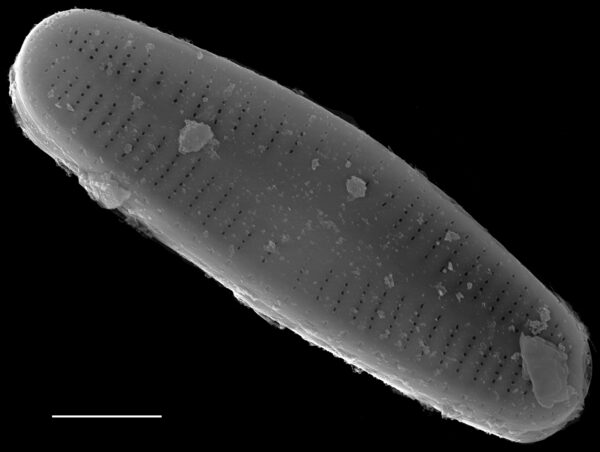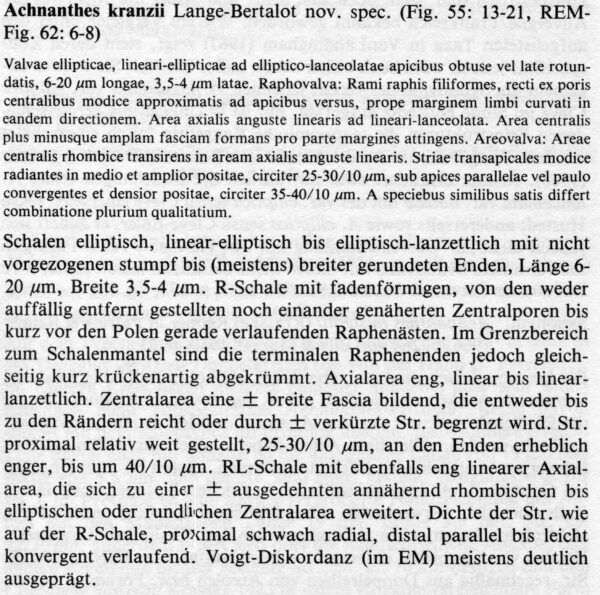Achnanthidium kranzii
-
Category
-
Length Range8-20 µm
-
Width Range2.8-3.8 µm
-
Striae in 10 µm24-30 in the center valve, up to 40 at the ends
-
ContributorMarina Potapova - Mar 2011
-
ReviewerSarah Spaulding - Mar 2011
Identification
Description
Frustules are monoraphid with a concave raphe valve and a convex rapheless valve. Valves are linear-lanceolate to linear-elliptical with slightly drawn-out ends. The raphe valve has a large rectangular central area that often extends to valve margins. The rapheless valve has an apically elongated elliptical or rhomboid central area. Proximal external raphe endings are simple. Terminal raphe fissures are short and sharply curved to the same side. Striae are moderately radiate in the center of both valves, becoming parallel at the apices, 24-30 in 10 µm in the central valve, up to 40 in 10 µm at the apices. Striae are uniseriate. One row of areolae is present on the valve mantle, visible in SEM. External areolae openings of areolae are very small and vary in shape from circular to transapically elongated.
Autecology
This taxon is known from streams in Alaska.
-
Size Range, µm3
-
Motility
-
Attachment
-
Habitat
-
Colony
-
Occurrence
-
Waterbody
- Learn more about this
Original Description
Valvae ellipticae, lineari-ellipticae ad elliptico-lanceolatae apicibus obtuse vel late rotundatis, 6-20 µm longae, 3.5-4 µm latae. Raphovalva: Rami raphis filiformes, recto ex poris centralibus modice approximatis, ad apicibus versus, prope marginem limbi curvati in eandem directionem. Area axialis anguste linearis ad lineari-lanceolata. Area centralis plus minusque amplam fasciam formans pro parte margines attingens. Areovalva: areae centralis rhombice transirens in aream axialis anguste linearis. Striae transapicales modice radiantes in medio at amplior positae, circiter 25-30/10 µm, sub apices parallelae vel paulo convergentes et densior positae, circiter 35-40/10 µm. A speciebus similibus satis differt combinatione pljurium qualitatium.
-
BasionymAchnanthes kranzii
-
AuthorLange-Bert. in Lange-Bert. and Krammer 1989
-
Length Range6-20 µm
-
Width3.5-4 µm
-
Striae in 10µm25-30 in the center valve, 35-40 at the ends
Citations & Links
Citations
Links
-
Index Nominum Algarum
-
GenBank
-
North American Diatom Ecological DatabaseNADED ID: 1027
Cite This Page
Potapova, M. (2011). Achnanthidium kranzii. In Diatoms of North America. Retrieved April 23, 2024, from https://diatoms.org/species/achnanthidium_kranzii
Responses
The 15 response plots show an environmental variable (x axis) against the relative abundance (y axis) of Achnanthidium kranzii from all the stream reaches where it was present. Note that the relative abundance scale is the same on each plot. Explanation of each environmental variable and units are as follows:
ELEVATION = stream reach elevation (meters)
STRAHLER = distribution plot of the Strahler Stream Order
SLOPE = stream reach gradient (degrees)
W1_HALL = an index that is a measure of streamside (riparian) human activity that ranges from 0 - 10, with a value of 0 indicating of minimal disturbance to a value of 10 indicating severe disturbance.
PHSTVL = pH measured in a sealed syringe sample (pH units)
log_COND = log concentration of specific conductivity (µS/cm)
log_PTL = log concentration of total phosphorus (µg/L)
log_NO3 = log concentration of nitrate (µeq/L)
log_DOC = log concentration of dissolved organic carbon (mg/L)
log_SIO2 = log concentration of silicon (mg/L)
log_NA = log concentration of sodium (µeq/L)
log_HCO3 = log concentration of the bicarbonate ion (µeq/L)
EMBED = percent of the stream substrate that is embedded by sand and fine sediment
log_TURBIDITY = log of turbidity, a measure of cloudiness of water, in nephelometric turbidity units (NTU).
DISTOT = an index of total human disturbance in the watershed that ranges from 1 - 100, with a value of 0 indicating of minimal disturbance to a value of 100 indicating severe disturbance.

Achnanthidium kranzii
- Valves linear-lanceolate to linear-elliptic
- Striae radiate in the center, parallel at the ends
- Raphe valve with large rectangular central area
- Rapheless valve with elliptic or rhomboid central area
- Terminal raphe fissures curved to one side
Valves are linear-lanceolate to linear-elliptic with slightly drawn-out ends. The raphe valve has a large rectangular central area that often extends to valve margin. The rapheless valve has an apically elongated elliptic or rhomboid central area. Terminal raphe fissures are sharply curved to the same side. Striae are uniseriate,...
 Diatoms of North America
Diatoms of North America











